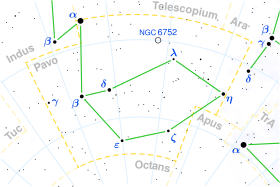Xi Pavonis
| Observation data Epoch J2000 Equinox J2000 | |
|---|---|
| Constellation | Pavo |
| Right ascension | 18h 23m 13.62473s[1] |
| Declination | −61° 29′ 38.0773″[1] |
| Apparent magnitude (V) | 4.35[2] |
| Characteristics | |
| Spectral type | K4III[2] |
| U−B color index | +1.55[3] |
| B−V color index | +1.46[2] |
| Astrometry | |
| Radial velocity (Rv) | +12.20[4] km/s |
| Proper motion (μ) | RA: +3.17[1] mas/yr Dec.: −2.21[1] mas/yr |
| Parallax (π) | 6.96 ± 1.03[1] mas |
| Distance | approx. 470 ly (approx. 140 pc) |
| Absolute magnitude (MV) | −1.16[2] |
| Orbit[5] | |
| Period (P) | 2,214 d |
| Eccentricity (e) | 0.26 |
| Periastron epoch (T) | 2418076.2 JD |
| Argument of periastron (ω) (secondary) | 187.2° |
| Semi-amplitude (K1) (primary) | 17.9 km/s |
| Details | |
| Luminosity | 650[2] L☉ |
| Temperature | 4,200[6] K |
| Other designations | |
| Database references | |
| SIMBAD | data |
Xi Pavonis (ξ Pavonis) is a class K4III[2] (orange giant) star in the constellation of Pavo. Its apparent magnitude is 4.35[2] and it is approximately 470 light years away based on parallax.[1] Xi Pavonis is the double star GLE 2AB, whose companion's magnitude is 8.6 about 3.3" separation, which was discovered by Australian amateur astronomer, Walter Gale in 1894. In addition, the primary is spectroscopic binary GLE 2Aa, with a 6.06 year period.[7][8]
References
- 1 2 3 4 5 6 Van Leeuwen, F. (2007). "Validation of the new Hipparcos reduction". Astronomy and Astrophysics. 474 (2): 653. arXiv:0708.1752. Bibcode:2007A&A...474..653V. doi:10.1051/0004-6361:20078357. Vizier catalog entry
- 1 2 3 4 5 6 7 Anderson, E.; Francis, Ch. (2012). "XHIP: An extended hipparcos compilation". Astronomy Letters. 38 (5): 331. arXiv:1108.4971. Bibcode:2012AstL...38..331A. doi:10.1134/S1063773712050015. Vizier catalog entry
- ↑ Mermilliod, J. C. (2006). "VizieR Online Data Catalog: Homogeneous Means in the UBV System (Mermilliod 1991)". VizieR On-line Data Catalog: II/168. Originally published in: Institut d'Astronomie. 2168. Bibcode:2006yCat.2168....0M. Vizier catalog entry
- ↑ Wilson, R. E. (1953). General Catalogue of Stellar Radial Velocities. Carnegie Institution of Washington. Bibcode:1953GCRV..C......0W. LCCN 54001336.
- ↑ Pourbaix, D.; et al. (2004), "SB9: The Ninth Catalogue of Spectroscopic Binary Orbits", Astronomy & Astrophysics, 424: 727–732, arXiv:astro-ph/0406573, Bibcode:2009yCat....102020P, doi:10.1051/0004-6361:20041213.
- ↑ McDonald, I.; Zijlstra, A. A.; Boyer, M. L. (2012). "Fundamental parameters and infrared excesses of Hipparcos stars". Monthly Notices of the Royal Astronomical Society. 427: 343. arXiv:1208.2037. Bibcode:2012MNRAS.427..343M. doi:10.1111/j.1365-2966.2012.21873.x. Vizier catalog entry
- ↑ Dommanget, J.; Nys, O. (2002). "VizieR Online Data Catalog: CCDM (Catalog of Components of Double & Multiple stars) (Dommanget+ 2002)". VizieR On-line Data Catalog: I/274. Originally published in: Observations et Travaux 54. 1274. Bibcode:2002yCat.1274....0D. Vizier catalog entry
- ↑ Malkov, O. Yu.; Tamazian, V. S.; Docobo, J. A.; Chulkov, D. A. (2012). "Dynamical masses of a selected sample of orbital binaries". Astronomy & Astrophysics. 546: A69. Bibcode:2012A&A...546A..69M. doi:10.1051/0004-6361/201219774. Vizier catalog entry
This article is issued from
Wikipedia.
The text is licensed under Creative Commons - Attribution - Sharealike.
Additional terms may apply for the media files.
